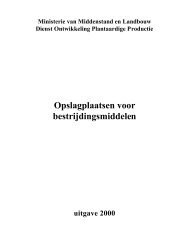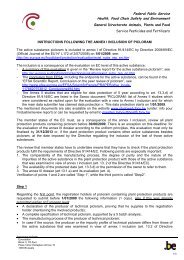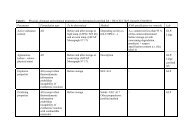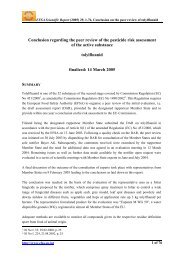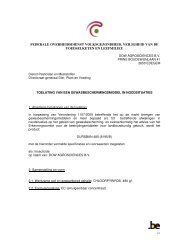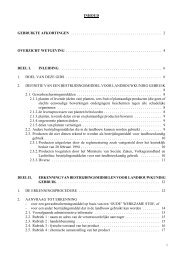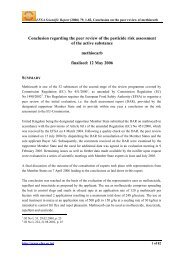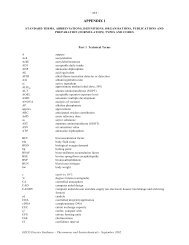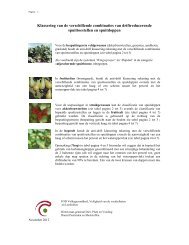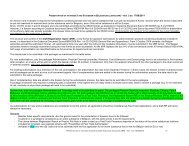Prediction <strong>of</strong> <strong>the</strong> toxicity <strong>of</strong> a binary mixture AB new in relation to a mixture AB oldOn <strong>the</strong> same foundations, a comparison <strong>of</strong> predicted effect values for overall toxicitydepending on <strong>the</strong> content <strong>of</strong> <strong>the</strong> impurity component A is possible (even without knowledgeon <strong>the</strong> actual toxicity <strong>of</strong> all mixture components).ECECx( ABold)( AB )xnew( f −1) × pnew( A)+( −1) × p ( A) + 1= fold1(4)The result <strong>of</strong> this calculation depends, on <strong>the</strong> one hand, on <strong>the</strong> respective content <strong>of</strong> <strong>the</strong>impurity component A in <strong>the</strong> “old” and <strong>the</strong> “new” mixture (i.e. reference and new source)and, on <strong>the</strong> o<strong>the</strong>r hand, on <strong>the</strong> factor f, by which <strong>the</strong> impurity component A is more toxic (oris assumed to be more toxic) than <strong>the</strong> active-substance component B.<strong>Assessment</strong> <strong>of</strong> <strong>the</strong> relevance <strong>of</strong> impuritiesFor all ecotoxicological assessment areas, where <strong>the</strong> new source is different from <strong>the</strong> batchesused in ecotoxicological testing according to <strong>the</strong> Tier I assessment, <strong>the</strong> predicted increase inecotoxicity <strong>of</strong> <strong>the</strong> new source must be calculated based on its actual composition (equation 4),unless a comparison <strong>of</strong> ecotoxicity is possible based on experimental data (see below). Thefollowing cases are distinguished with regard to <strong>the</strong> selection <strong>of</strong> a value for <strong>the</strong> factor f.- A factor f = 100 is applied by default. This reflects a conservative approach in caseswhere <strong>the</strong> toxic action <strong>of</strong> <strong>the</strong> technical active substance against <strong>the</strong> organismconsidered is not determined by <strong>the</strong> intended pesticidal mode-<strong>of</strong>-action (e.g., effectson fish through a herbicide) or ano<strong>the</strong>r known specific mechanism. In such cases, astrong impact <strong>of</strong> an impurity compound on <strong>the</strong> overall toxicity <strong>of</strong> a technical activesubstance against <strong>the</strong> tested organism cannot be excluded with sufficient certainty.- The factor may be lowered to f = 10 where it can be plausibly assumed that <strong>the</strong> toxicaction <strong>of</strong> <strong>the</strong> technical active substance against <strong>the</strong> tested organism is determined by<strong>the</strong> intended pesticidal mode-<strong>of</strong>-action (e.g., effects <strong>of</strong> a herbicide on algae) or whereexisting knowledge (e.g., typical toxicity pr<strong>of</strong>iles <strong>of</strong> classes <strong>of</strong> active substances)confirms that a specific toxic mechanism <strong>of</strong> <strong>the</strong> active substance against <strong>the</strong> testedorganism may be assumed.b) <strong>Assessment</strong> <strong>of</strong> bridging studies in order to prove ecotoxicological representativenessIf studies exist that allow a direct comparison <strong>of</strong> <strong>the</strong> ecotoxicity <strong>of</strong> a new source against <strong>the</strong>ecotoxicity <strong>of</strong> a reference batch, <strong>the</strong> results from <strong>the</strong>se studies should be used for assessing <strong>the</strong>equivalence <strong>of</strong> a new source and reference batch. As a prerequisite for such an assessment,both studies must be carried out according to <strong>the</strong> same testing methodology, under identicalexposure conditions (e.g., static, flow-through) and with <strong>the</strong> same test species.Fur<strong>the</strong>rmore, bridging is only possible between groups <strong>of</strong> organisms where it can be assumedthat <strong>the</strong> effects <strong>of</strong> <strong>the</strong> test substance in both groups are caused by <strong>the</strong> same mode-<strong>of</strong>-action. In<strong>the</strong> case, e.g., <strong>of</strong> a herbicidal active substance, bridging is usually only possible betweenaquatic plants, but not from aquatic plants to invertebrates.Bridging between acute and prolonged testing is in principle possible. If a study indicates that<strong>the</strong> acute toxicity <strong>of</strong> <strong>the</strong> new source mixture is determined by <strong>the</strong> pure active substance, it isconsidered unlikely that effect levels on <strong>the</strong> prolonged time scale will be determined by <strong>the</strong>impurity.12
Bridging across different media (e.g., from aquatic to terrestrial insects) is possible based on acase-by-case decision, if <strong>the</strong> comparability <strong>of</strong> effect characteristics (mode-<strong>of</strong>-action anduptake) is plausibly founded.Limit tests may be appropriate for bridging purposes when it can be ensured that <strong>the</strong>uncertainty around <strong>the</strong> measured effect level fully lies within <strong>the</strong> range <strong>of</strong> <strong>the</strong> acceptabledeviation (see 6.2.2) from <strong>the</strong> effect level in <strong>the</strong> corresponding test with <strong>the</strong> reference source.7.2.2 Decision makingThe generic approach under 6.2.1 a) should be applied in all cases where no experimentalecotoxicity data or reliable modelled ecotoxicity values are available for <strong>the</strong> new source. As aresult <strong>of</strong> such an assessment, an impurity must be considered relevant and hence <strong>the</strong> newsource considered not equivalent when <strong>the</strong> increase <strong>of</strong> predicted ecotoxicity according to <strong>the</strong>calculation for <strong>the</strong> new source as compared to <strong>the</strong> reference specification for <strong>the</strong> respectiveorganism group (birds, small mammals, aquatic organisms, non-target arthropods, soilorganisms, terrestrial non-target plants) exceeds a factor <strong>of</strong> 2. To finally conclude on <strong>the</strong>relevance, bridging studies as described under 6.2.1 b) are <strong>the</strong>n typically necessary. As longas <strong>the</strong> predicted increase in ecotoxicity remains smaller than a factor <strong>of</strong> 2, <strong>the</strong> impurity isconsidered not relevant and hence <strong>the</strong> new source considered equivalent. In this case, it can beassumed with sufficient certainty that <strong>the</strong> increased content <strong>of</strong> <strong>the</strong> impurity compound in <strong>the</strong>new source will not cause a serious increase in <strong>the</strong> ecotoxicity <strong>of</strong> this new source compared to<strong>the</strong> respective batches used in ecotoxicological testing for <strong>the</strong> assessment <strong>of</strong> <strong>the</strong> referencesource.Example calculations to illustrate <strong>the</strong> application <strong>of</strong> <strong>the</strong> generic approach are attached inAppendix VI.Where experimental or reliable modelled data are available for <strong>the</strong> new source, <strong>the</strong>ecotoxicological pr<strong>of</strong>ile will be considered equivalent to that <strong>of</strong> <strong>the</strong> reference pr<strong>of</strong>ile where<strong>the</strong> ecotoxicological data provided on <strong>the</strong> technical a.s. do not differ by more than a factor <strong>of</strong>3 compared to <strong>the</strong> reference (or by <strong>the</strong> appropriate spacing factor <strong>of</strong> <strong>the</strong> respective test system,if greater than 3), when determined using <strong>the</strong> same species. (Note: this factor is meant toaccount for <strong>the</strong> variability <strong>of</strong> ecotoxicological test results and must not be interpreted as if anactual difference in ecotoxicity with a factor < 3 was in principle irrelevant with regard to <strong>the</strong>risk assessment).13



